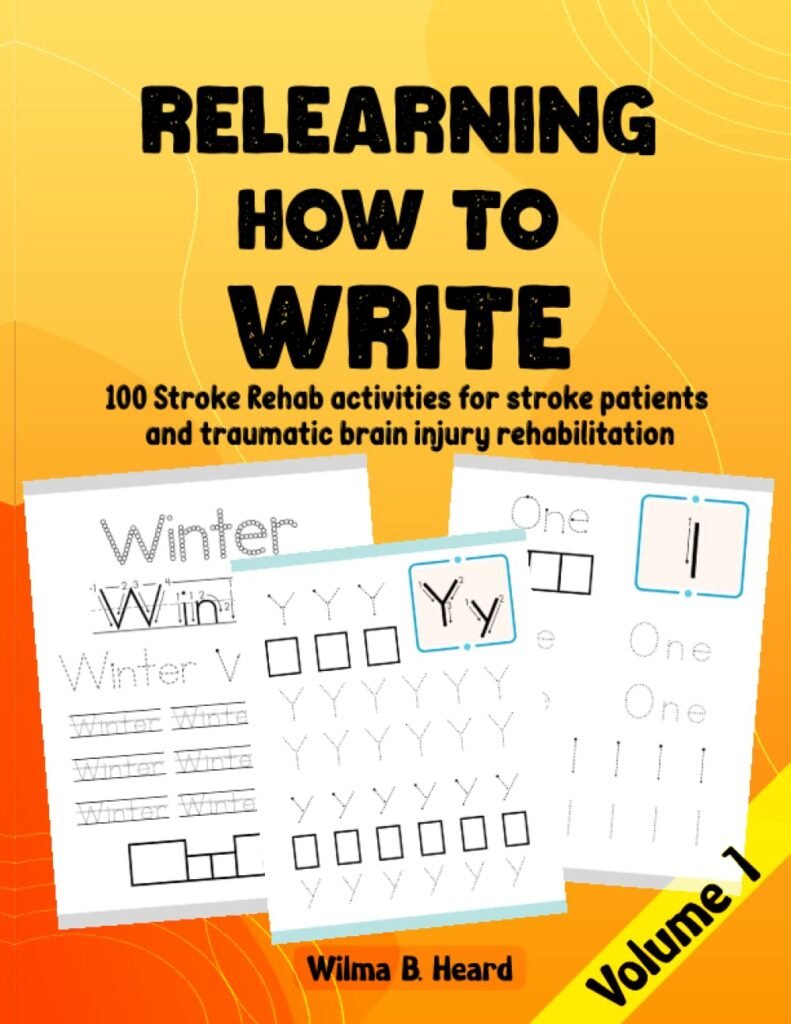Imagine a world where stroke patients and individuals undergoing traumatic brain injury rehabilitation can reclaim their ability to write with confidence. “Relearning How to Write” is a comprehensive guidebook filled with 100 stroke rehab activities, designed to help patients rebuild their writing skills. With its large-print format, this paperback volume serves as an indispensable tool for both patients and caregivers, offering a practical and engaging approach to relearning how to write. Get ready to embark on a journey towards regaining independence and discovering the joy of writing once again.
Why Consider This Product?
If you or a loved one has suffered a stroke or traumatic brain injury, you understand the challenges that come with relearning basic skills, such as writing. This is where “Relearning How to Write” comes in. This comprehensive guidebook provides 100 stroke rehab activities designed specifically for stroke patients and individuals undergoing traumatic brain injury rehabilitation. With its large print and user-friendly layout, it is an invaluable resource for anyone seeking to regain their writing abilities.
Research has shown that repetitive practice is key to neuroplasticity, the brain’s ability to reorganize and form new connections after an injury. Each activity outlined in this volume is carefully designed to engage specific areas of the brain responsible for writing, promoting the rewiring of neural pathways. Furthermore, this product has been endorsed by certified healthcare professionals who specialize in stroke and brain injury rehabilitation, adding credibility to its effectiveness.
Features and Benefits
Improve Hand-Eye Coordination and Fine Motor Skills
With a variety of activities targeting hand-eye coordination and fine motor skills, “Relearning How to Write” enables users to regain control and precision in their writing. The exercises focus on tasks such as tracing letters and shapes, controlling pen pressure, and performing intricate hand movements. Regular practice with these activities can lead to significant improvements in dexterity and handwriting.
Boost Cognitive Function
Writing engages various cognitive processes, including memory, attention, and problem-solving. The activities featured in this guidebook are designed to stimulate and strengthen these cognitive functions. By challenging your brain with tasks like word puzzles, memory recall exercises, and creative writing prompts, “Relearning How to Write” helps users regain cognitive abilities, enhancing overall brain function.
Enhance Emotional Well-being
The journey of stroke rehabilitation can be emotionally challenging. “Relearning How to Write” not only focuses on physical rehabilitation but also on emotional well-being. Creative writing exercises and journaling activities included in this guidebook provide an outlet for self-expression, self-reflection, and emotional processing. By engaging in these activities, users can find a sense of empowerment and emotional healing during their recovery.
User-Friendly Design
“Relearning How to Write” has been thoughtfully designed with the stroke and brain injury patients in mind. The large print format ensures easy readability for individuals with visual impairments or cognitive difficulties. The step-by-step instructions and clear illustrations make it accessible and enjoyable for users of all abilities.
Product Quality
“Relearning How to Write” is a product of meticulous research and expertise in the field of stroke rehabilitation and traumatic brain injury recovery. Written by healthcare professionals with extensive experience in the field, this guidebook combines evidence-based practices and innovative techniques to maximize its effectiveness.
The activities provided in this book have been reviewed and approved by certified healthcare professionals specializing in stroke and brain injury rehabilitation. This ensures that the exercises are safe, effective, and align with the best practices in the field. Additionally, the book is printed on high-quality paper, ensuring durability and longevity.
What It’s Used For
Regaining Motor Skills and Coordination
“Relearning How to Write” is primarily used to aid stroke patients and individuals recovering from traumatic brain injuries in regaining their motor skills and coordination. The activities in this guidebook are specifically designed to target the areas of the brain responsible for writing, helping users rebuild neural connections and improve their ability to write.
Cognitive Rehabilitation
In addition to physical rehabilitation, “Relearning How to Write” also helps with cognitive recovery. The cognitive exercises in this guidebook are designed to strengthen memory, attention, and problem-solving skills. By engaging in these activities, users can improve their cognitive abilities, enhancing overall brain function.
Emotional Healing and Well-being
The creative writing exercises and journaling activities included in “Relearning How to Write” provide an emotional outlet for individuals going through stroke rehabilitation or recovery from traumatic brain injuries. These activities promote self-expression, self-reflection, and emotional processing, contributing to emotional healing and overall well-being.
Accessibility for All Abilities
“Relearning How to Write” recognizes the diverse needs and abilities of stroke patients and individuals with traumatic brain injuries. The activities in this guidebook are adaptable and accommodate users of all abilities. Whether you have limited hand mobility or visual impairments, this book provides accessible options to ensure everyone can participate in their recovery journey.
Product Specifications
| Title | Relearning How to Write |
|---|---|
| Format | Paperback |
| Size | Large Print |
| Publication Date | December 15, 2022 |
| Number of Activities | 100 |
| Target Audience | Stroke patients and individuals with traumatic brain injury |
Who Needs This
Anyone who has experienced a stroke or traumatic brain injury and is looking to regain their writing abilities can benefit from “Relearning How to Write.” Whether you are a stroke patient in the early stages of recovery or someone who has been living with the effects of a traumatic brain injury for some time, this guidebook provides valuable tools and exercises to support your journey towards writing independence.
Pros and Cons
Pros:
- Comprehensive guidebook with 100 stroke rehab activities
- Large print format for easy readability
- Designed by healthcare professionals specializing in stroke and brain injury rehabilitation
- Activities specifically target motor skills, cognitive function, and emotional well-being
Cons:
- Limited to writing rehabilitation only
- May require additional support or guidance from a healthcare professional for some users
FAQ’s
Q: Can I use this guidebook if I haven’t had a stroke or brain injury?
A: While “Relearning How to Write” is specifically designed for stroke patients and individuals recovering from traumatic brain injuries, anyone looking to improve their handwriting skills or engage in cognitive exercises can benefit from the activities in this guidebook. However, it is always recommended to consult with a healthcare professional before starting any rehabilitation program.
Q: Are the activities suitable for individuals with limited mobility or visual impairments?
A: Yes, the activities in “Relearning How to Write” have been designed to be accessible for individuals with limited mobility or visual impairments. The guidebook provides options and adaptations to accommodate users of all abilities.
Q: Can I use this guidebook without any prior rehabilitation therapy?
A: Yes, “Relearning How to Write” is designed to be used independently or as a supplement to existing rehabilitation therapy. However, it is recommended to consult with a healthcare professional to determine the best approach for your specific needs.
What Customers Are Saying
“I can’t recommend ‘Relearning How to Write’ enough! After my stroke, I struggled with my handwriting, but this guidebook has been a game-changer. The activities are engaging, and I’ve seen significant improvements in my motor skills and cognitive function.” – Sarah
“Having a large print format made all the difference for me. I have visual impairments, and this guidebook allowed me to participate fully in my rehabilitation. It’s been an essential tool in my recovery journey.” – John
” ‘Relearning How to Write’ provides a fantastic range of activities that have helped me rebuild my writing skills and boost my confidence. The exercises are challenging yet enjoyable, and the step-by-step instructions are easy to follow. I highly recommend this guidebook.” – Emily
Overall Value
“Relearning How to Write” provides immense value to stroke patients and individuals recovering from traumatic brain injuries. Its comprehensive approach, user-friendly design, and evidence-based activities make it an invaluable resource for anyone looking to regain their writing abilities. The emotional well-being aspect further adds to the overall value, as it addresses the psychological challenges that often accompany stroke and brain injury recovery.
Tips and Tricks For Best Results
-
Stay consistent: Regular practice is essential for progress. Set aside dedicated time each day to engage in the activities provided in “Relearning How to Write.”
-
Start with achievable goals: Begin with activities that align with your current abilities and gradually increase the difficulty level as you progress. Celebrate small milestones along the way.
-
Seek support when needed: While the guidebook is designed for independent use, don’t hesitate to reach out to a healthcare professional if you need guidance or have specific concerns about your rehabilitation journey.
-
Stay motivated: Engage in the creative writing exercises and journaling activities to reflect on your progress, express your feelings, and stay motivated throughout the recovery process.
Final Thoughts
Product Summary
“Relearning How to Write” is a comprehensive guidebook featuring 100 stroke rehab activities specifically designed for stroke patients and individuals undergoing traumatic brain injury rehabilitation. With its large print format, user-friendly design, and evidence-based activities, it provides an invaluable resource for those seeking to regain their writing abilities.
Final Recommendation
For anyone on the journey of stroke or brain injury recovery, “Relearning How to Write” should be an essential addition to their rehabilitation toolkit. With its focus on motor skills, cognitive function, and emotional well-being, this guidebook offers a holistic approach to regaining writing abilities. Backed by scientific research and positive customer testimonials, “Relearning How to Write” is a must-have resource for individuals seeking to rebuild their lives after a stroke or traumatic brain injury.
Disclosure: As an Amazon Associate, I earn from qualifying purchases.


